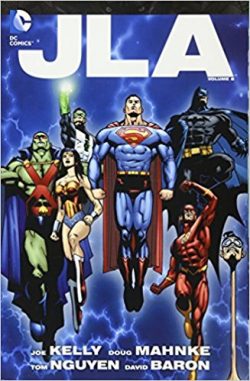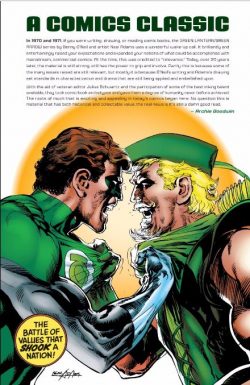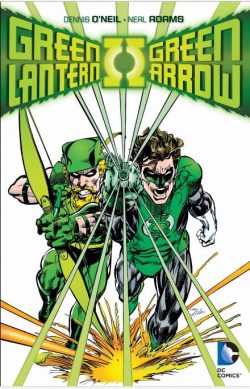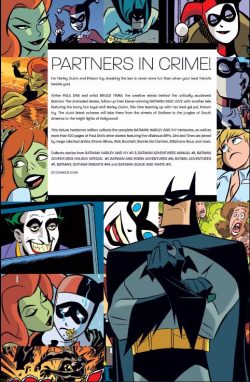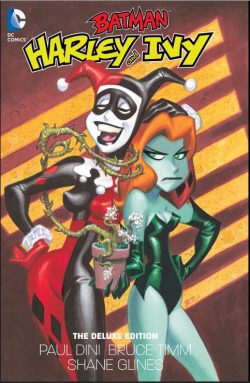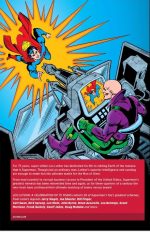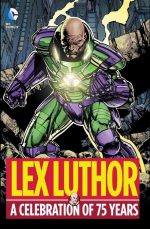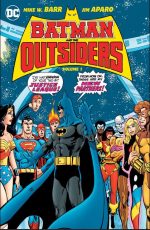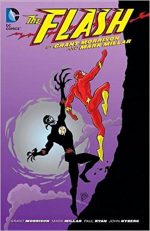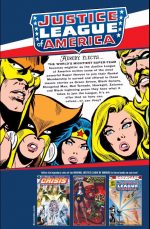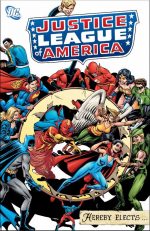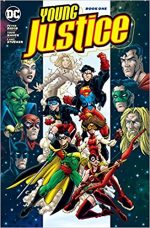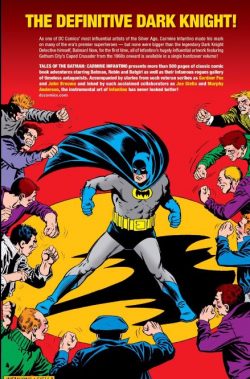
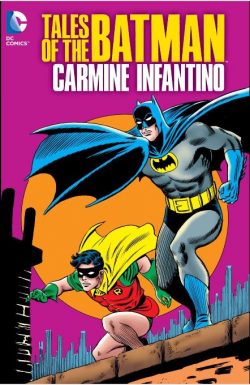
By Carmine Infantino, Gardner Fox, John Broome, Cary Bates, Gerry Conway, Don Kraar, Mike Barr, Geoff Johns & various (DC Comics)
ISBN: 978-1-4012-4755-3
Win’s Christmas Gift Recommendation: Timeless Fun foe One and All … 9/10
Born on May 24th 1925, Carmine Michael Infantino was one of the greatest comic artists America ever produced; a multi-award-winning innovator who was there when comicbooks were born, reshaped the industry in the Silver Age and was still making fans when he died in 2013
As an artist he co-created and initially visualised The Black Canary, Detective Chimp, Pow-Wow Smith, the Silver Age Flash, Elongated Man, Deadman, Batgirl, Dial H for Hero and Human Target and revitalised characters such as Adam Strange and Batman. He worked for many companies, and at Marvel ushered in a new age by illustrating the licensed Star Wars comicbook and working on titles such as Avengers, Daredevil, Ms. Marvel, Nova, Star-Lord and Spider-Woman…
His work on two iterations of the Batman newspaper strip are fondly remembered and whilst acting as Art Director and Publisher of National DC oversaw the most critically acclaimed period in the company’s history, ushering in the “relevancy†era and poaching Jack Kirby from Marvel to create the Fourth World, Kamandi, The Demon and others…
Very much – and repeatedly – the right man in the right time and place, Infantino shaped American comicbook history like few others, and this hardcover compendium (and eBook) dedicated to his contributions to the lore of Batman collects the stunning covers from Detective Comics #327-347, 349, 351-371, 500 and Batman #166-175, 181, 183-185, 188-192, 194-199 plus the Bat-Saga stories he drew for Detective #327, 329, 331, 333, 335, 337, 339, 341, 343, 345, 347, 349, 351, 353, 357, 359, 361, 363, 366-367, 369, and 500.
Also included are the contents of The Brave and the Bold #172, 183, 190, 194 and DC Comics Presents: Batman #1: an artistic association cumulatively spanning May 1964 to September 2004.
I’m assuming everybody here loves comics and that we’ve all had the same unpleasant experience of trying to justify that passion to somebody. Excluding your partner (who is actually right – the living room floor is not the place to leave your $£#!D*&$£! funnybooks) even today, many people still have an entrenched and erroneous view of strip art, resulting in a frustrating and futile time as you tried to dissuade them from that opinion.
If so, this collection might be the book you want next time that confrontation occurs, offering breathtaking examples of the prolific association of one the industry’s greatest illustrators with possibly the artform’s greatest creation.
Many of these “Light Knight†sagas stem from a period which saw the Dynamic Duo, remoulded, reshaped and set up for global Stardom – and subsequent fearful castigation from fans – as the template for the Batman TV show of the 1960s. It should be noted, however, that the television producers and researchers took their creative impetus from stories of the era preceding the “New Look Batman†– as well as the original movie serial of the 1940s…
So, what happened?
By the end of 1963, Julius Schwartz had revived much of National/DC’s line – and the entire industry – with his modernization of the superhero, and was then asked to work his magic with the creatively stalled and nigh-moribund Caped Crusader.
Bringing his usual team of top-notch creators with him, Schwartz stripped down the core-concept, downplaying aliens, outlandish villains and daft transformation tales to bring a cool modern take to the capture of criminals: even overseeing a streamlining rationalisation of the art style itself.
The most apparent innovation was a yellow circle around the Bat-symbol, but far more importantly, the stories also changed. A subtle aura of genuine menace had re-entered the comfortable and absurdly abstract world of Gotham City.
Infantino was key to the changeover, which reshaped a legend – but this was while still pencilling Silver Age superstar The Flash – so, despite generating the majority of covers, Infantino’s interior art was limited to alternate issues of Detective Comics with the lion’s share of narrative handled by Bob Kane’s uncredited deputies Sheldon Moldoff, Joe Giella, Chic Stone & others, or occasional guest artists such as Gil Kane…
Punctuated throughout this collection by his chronologically sequenced covers, Infantino’s part in the storytelling revolution began then and kicks off here with Detective #327 – written by John Broome and inked by Joe Giella at the very peak of their own creative powers.
‘The Mystery of the Menacing Mask! is a cunning “Howdunnit?â€, long on action and moody peril, as discovery of a criminal “underground railroad†leads Caped Crusaders Batman and Robin to a common thug seemingly able to control the heroes with his thoughts…
‘Castle with Wall-To-Wall Danger!’ (Detective #329 with Broome and Giella in their respective roles) follows: a captivating international thriller which sees the heroes braving a deadly death-trap in Swinging England in pursuit of a dastardly thief.
A rare full-length story in #331 guest-starred Elongated Man (Detective Comics‘ back-up feature: a costumed sleuth blending the charm of Nick “Thin Man†Charles with the outré heroic antics of Plastic Man).
The ‘Museum of Mixed-Up Men’ (Broome & Infantino) teamed the eclectic enigma-solvers against a super-scientific felon, whilst in #333 Bat Man & Robin fought against a faux goddess and genuine telepaths in the ‘Hunters of the Elephants’ Graveyard!’, written by Gardner Fox and inked by Giella.
The same team revealed the ‘Trail of the Talking Mask!’ in #335, giving the Dynamic Duo an opportunity to reinforce their sci-fi credentials in a classy high-tech thriller guest-starring private detective Hugh Rankin (of Mystery Analysts of Gotham City fame) before ‘The Deep-Freeze Menace!’ (Detective #337 introduced a fearsome fantasy chiller pitting Batman against a super-powered caveman encased in ice for 50,000 years…
DC’s inexplicable (but deeply cool) long-running love-affair with gorillas resulted in a cracking doom-fable as ‘Batman Battles the Living Beast-Bomb!’ in #339, highlighting the hero’s physical prowess in a duel of wits and muscles against a sinister, super-intelligent simian.
Up until this time the New Look Batman was forging his more realistic path, as the TV series was still in pre-production. The Batman television show (premiering on January 12th, 1966 and running for three seasons of 120 episodes in total) show aired twice weekly for its first two seasons, resulting in vast amount of Bat-awareness, no end of spin-offs and merchandise – including a movie – and the overkill phenomenon of “Batmaniaâ€.
No matter how much we might squeal and foam about it, a huge portion of this planet’s population Batman is always going to regard that “Zap! Biff! Pow!†buffoonish costumed boy scout as The Real Deal…
Regrettably this means that the comic stories published during that period have been similarly excoriated and maligned by most Bat-fans ever since. It is true that some tales were crafted with overtones of the “camp†fad, presumably to accommodate newer readers seduced by the arch silliness and coy irony of the show, but no editor of Julius Schwartz’s calibre would ever deviate far from the characterisation that had sustained Batman for nearly thirty years, or the then-recent re-launch which had revitalised the character sufficiently for television to take an interest at all.
Nor would such brilliant writers as John Broome, Bill Finger, Gardner Fox and Robert Kanigher ever produce work which didn’t resonate on all the Batman’s intricate levels just for a quick laugh and a cheap thrill. The artists tasked with sustaining the visual intensity included Infantino, Moldoff, Stone, Giella, Murphy Anderson and Sid Greene, with covers from Gil Kane and Joe Kubert supplementing Infantino’s stunning, trend-setting, fine-line masterpieces.
Most of the tales here reflect those gentler times and editorial policy of focusing on Batman’s reputation as “The World’s Greatest Detectiveâ€, so colourful, psychotic costumed super-villains are still in a minority, but there are first appearances for a number of exotic foes who would become regular menaces for the Dynamic Duo in years to come.
Broome & Infantino then detailed the screen-inspired, comedically-catastrophic campaign of ‘The Joker’s Comedy Capers!’ in #341 and the mayhem and mystery continued in Detective Comics #343 (September 1965) with ‘The Secret War of the Phantom General!’: a tense thriller pitting our hard-pressed heroes against a hidden army of gangsters and Nazi war criminals.
Detective #345 debuted a terrifying and tragic new villain in ‘The Blockbuster Invasion of Gotham City!’ (scripted by Fox). Here a monstrous giant with the mind of a child and the raw, physical power of a tank is constantly driven to madness at sight of Batman and only placated by the sight of Bruce Wayne…
‘The Strange Death of Batman!’ (Fox, Detective# 347) saw the opening shot of habitual B-list villain the Bouncer in a bizarre experimental yarn which has to be seen to be believed, whereas it’s business as usual when monstrous, microcephalic man-brute returns in ‘The Blockbuster Breaks Loose!’: a blistering, action-fuelled thriller by Fox, Infantino & Giella from Detective #349. This tale sports a cover by Infantino’s colleague Joe Kubert whilst also hinting at the return of a long-forgotten foe…
Detective #351 premiered game-show host turned felonious impresario Arthur Brown in a twisty, puzzle-packed battle of wits detailing ‘The Cluemaster’s Topsy-Turvy Crimes!’ (Fox, Infantino & Sid Greene) after which the action continues with ‘The Weather Wizard’s Triple-Treasure Thefts!’ (Fox/Giella in #353).
The Dynamic Duo battle in spectacular opposition to the Flash’s meteorological arch-enemy: one of the first times a DC villain moved out of his usually stamping grounds whilst Detective #357 delivers a clever secret identity saving puzzler when – apparently – ‘Bruce Wayne Unmasks Batman!’ (Broome, Infantino & Giella) as prelude to big changes in the Batman mythos…
After three seasons (perhaps two and a half would be more accurate) the Batman TV show ended in March, 1968. It had clocked up 120 episodes since the US premiere. The era ended but the series had had an undeniable effect on the world, the comics industry and most importantly on the characters and history of its four-colour inspiration. Most notable was a whole new caped crusader who became an integral part of the DC universe.
The comic-book premiere of that aforementioned new character came in ‘The Million Dollar Debut of Batgirl’ (Detective Comics#359, cover-dated January 1967). Gardner Fox provided art team supreme Infantino & Greene a ripping yarn to introduce Barbara Gordon: mousy librarian and daughter of the venerable Police Commissioner into the superhero limelight. Thus, by the time the third season began on September 14th, 1967, she was well-established among comics fans at least….
A different Batgirl – Betty Kane, teenaged niece of the 1950s Batwoman – was already a nearly-forgotten comics fixture but for reasons far too complex and irrelevant to mention was conveniently ignored to make room for a new, empowered woman in the fresh tradition of Emma Peel, Honey West and the Girl From U.N.C.L.E. She was considered pretty hot too, which is always a plus for television…
Whereas she fought the Penguin on the small screen, her print origin features the no less ludicrous but at least visually forbidding Killer Moth in a clever yarn that still stands up today.
Editor Schwartz always preferred to play-up mysteries and crime conundrums in Detective Comics and #361’s ‘The Dynamic Duo’s Double-Deathtrap!’ was one of Fox’s best, especially as drawn by the now increasingly over-stretched Infantino and Greene. The plot involves Cold War spies and a maker of theatrical paraphernalia; I shall reveal no more to keep you guessing when you read it…
Detective #363 was a full co-starring vehicle as the Dynamic Duo challenged the new Batgirl to deduce Batman’s secret identity whilst tracking down the enigmatic Mr. Brains in ‘The True-False Face of Batman!’ and led to a taut suspense thriller stretching across Detective #366 and 367 – an almost unheard-of event in those cautiously reader-friendly days…
As devised by Fox, Infantino & Greene ‘The Round Robin Death Threats’ involves a diabolical murder-plot threatening to destroy Gotham’s worthiest citizens, with the tension peaking and the drama concluding in high style with ‘Where There’s a Will… There’s a Slay!’: a dark and deadly denouement barely marred by that dreadful title…
It was just a symptom of the times – as is Detective #369 (November 1967) – which somewhat reinforces boyhood prejudices about icky girls in the otherwise classy thriller ‘Batgirl Breaks Up the Dynamic Duo!’
Here Robin seemingly abandons Batman for a curvy new partner, but the best of clandestine reasons, ignominiously signalling – other than for the occasional cover – the end of Infantino’s tenure as a bat-illustrator.
His next contribution on view here came in anniversary landmark Detective Comics #500 (March 1981): part of a huge creative jam-session: specifically examining the legend of the immortal hero in ‘What Happens When a Batman Dies?’
Scripted by Cary Bates and inked by Bob Smith, this chapter co-stars restless revenant Deadman as the Gotham Guardian hovers in a coma between this world and the next, yet still manages to find a way to save himself…
The cover is another collaborative effort with Dick Giordano, José Luis GarcÃa-López, Joe Kubert and Tom Yeates all joining forces.
Next up; a quartet of tales from The Brave and the Bold, with Jim Aparo providing covers whilst Infantino handled interior art. Issue #172 (March 1981, and inked by Steve Mitchell) paired the Caped Crimebuster with Firestorm in the Gerry Conway scripted ‘Darkness and Dark Fire’, with the World’s Greatest Detective striving to solve the mystery of the Nuclear Man’s periodic mental blackouts, after which #183 (February 1982, written by Don Krarr and inked by Mike DeCarlo) sees our hero join forces with The Riddler to prevent ‘The Death of Batman!’
Scripter Mike Barr and inker Sal Trapani worked with Infantino on B&B #190 (September 1982) and #194 January 1993), respectively challenging the Dark Knight to visit planet Rann and find out ‘Who Killed Adam Strange?’ before subsequently working with the Flash against Doctor Double-X and the Rainbow Raider when they ‘Trade Heroes – And Win!’
One final Infantino fling comes from DC Comics Presents: Batman #1 (September 2004), courtesy of writer Geoff Johns, with inks by Giella and a retro cover from Ryan Hughes, as ‘Batman of Two Worlds’ gets real metaphysical with narrative boundaries as the modern Batman and Robin investigate murder on the set of the 1960s Batman TV show in a bizarrely engaging romp with a mystery villain to expose…
The visual cavalcade then ends on a nostalgic high with ‘Batman and Robin Retail poster’ – AKA the front cover of this titanic tome – possibly the most iconic bat-image of the era.
Whether you tend towards the anodyne light-heartedness of then, the socially acceptable psychopathy of the assorted movie franchises or actually just like the comicbook character, if you can make a potential convert sit down, shut up and actually read these wonderful adventures for all (reasonable) ages, you might find that the old adage “Quality will out†still holds true. And if you’re actually a fan who hasn’t read this classic stuff and revelled in the astounding timeless art, you have an absolute treat in store…
© 1964, 1965, 1966, 1967, 1981, 1982, 1983, 2004, 2014 DC Comics. All Rights Reserved.

